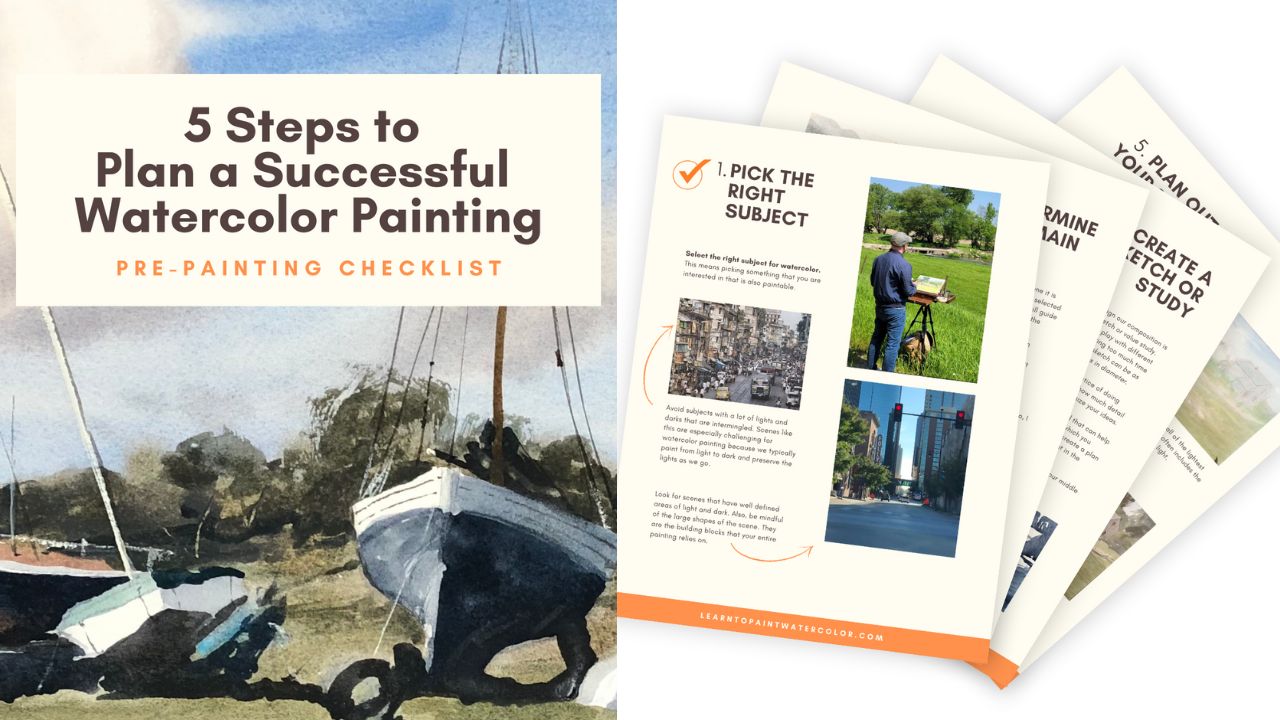Use Reference Photos to Create Beautiful Watercolors
Oct 09, 2023While I love plein air painting, much of my painting happens in my studio. And when I work inside, I often use reference photos as inspiration to paint a watercolor scene.
But rarely do I find a photograph ready to be painted as is. Before you try to paint a watercolor from a photograph, remember that you have the creative license to change whatever you want about the scene in front of you.
Today, I am going to teach you 3 strategies I use when working from a reference photo.
3 Ways to Use Photos to Create Gorgeous Watercolor Paintings
Enjoy this post? Like this Pin!
1. Crop your Photographs for a Compelling Composition.
So the first thing that we need to do is look at your scene and find that right composition. When we do this we can zoom in, change orientation, and crop certain elements out.
First, explore how you want the particular scene you are painting to be oriented: landscape or portrait. Experiment with it a bit. Pull it up on your phone or computer and crop it a few different ways, assessing which one looks good to you.
A good rule when you're thinking about cropping your photo is to think about the rule of thirds. If you're not familiar with the rule of thirds, it's simply dividing your painting by two horizontal lines and two vertical lines, as shown below.

Typically, the intersection of the lines are where you want the most important parts of your painting to line up. So, as you're cropping your photo and making choices about what you want to include, imagine these lines overlayed onto the scene.
It's also helpful to think about the horizon line when you are making decisions about composition. Make sure your horizon line isn't right in the middle of your painting. Instead, have it favor the top third or the bottom third. When you're making this decision, think what is more important: what is going on in the sky, or what is going on on the ground of the scene. This will help you decide which way you need to compose this.
2. Simplify and Edit Your Scene into a Focused, Paintable Scene.
The next thing you need to do when you're translating a photo into a painting is to edit. Remember, you're allowed to move things around. You're allowed to take elements of the photo out, even.
There is so much information in every photograph that we take - sometimes too much information - so we need to decide what is important and what isn't important. From there, we can remove things from the scene or situate certain things to create a more compelling composition.

For example, maybe there's too many boats in this scene. Maybe there's too many verticals. Maybe there's more buildings than you want. Unless your goal is to replicate a certain scene, give yourself permission to change whatever will improve your watercolor painting.
3. Determine the Main Idea of your Painting.
Point number three is: determine the main idea of your painting. As you crop your photo and remove unnecessary details, you're doing some of this work already.
It is helpful, though, to further solidify why you are selecting the scene by answering questions like:
- What is it about this photo that is exciting to me?
- What do I want to highlight about this scene?
- Where does my eye land when I study this picture?
Why is it helpful to think about this beforehand? Well, we don't want to leave to chance whether the main idea of our painting is noticed by our viewer. We have tools at our disposal to emphasize and highlight the focus of our scene, tools that attract the viewer's eye.
Tools like edge, contrast, and saturation.
If you want to study some watercolor paintings that showcase these tools being used in an exquisite manner, search for watercolors by Andy Evansen. He is a masterful watercolor artist, and is exemplary in this particular skill.
Here are a few of his paintings:



Evansen is excellent at selecting what is important and obscuring other details, like minimizing the background of the scene. You look at his paintings and you can see exactly what the main idea is. This is what's most important.
Examples of How to Paint a Watercolor from a Reference Photo
I had a student of mine from Watercolor Community reach out to me recently asking me about how to use reference photos to paint watercolors. She sent me some of her photos with some watercolor subjects she wanted to paint.

Here are some options we came up with for how to use this photo as inspiration for her watercolors:

This cut declutters the scene and makes it much clearer what the focus of the painting is. You'd probably want to eliminate the boat mast interrupting the scene and make the focus some of the buildings near the water.

This cut is similar, but orients the scene differently. It also features a boat in the foreground. You might want to eliminate some of the other boats in the water so it's not so cluttered.
 If you went with something like this, you'd likely want to simplify the architecture on the left and eliminate some of the boats from the water to make sure your watercolor scene isn't too busy and your focus is clear.
If you went with something like this, you'd likely want to simplify the architecture on the left and eliminate some of the boats from the water to make sure your watercolor scene isn't too busy and your focus is clear.
Related Blogs
The Secret to Great Watercolor Composition
What to do When You Don't Know What to Paint
Composition in Watercolor Painting - 3 Tips to Create Captivating Art

